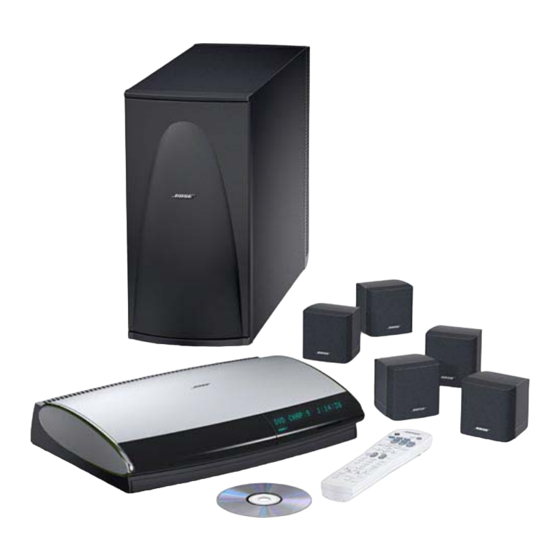Bose Lifestyle PS 18 Посібник з експлуатації - Сторінка 37
Переглянути онлайн або завантажити pdf Посібник з експлуатації для Спікери Bose Lifestyle PS 18. Bose Lifestyle PS 18 43 сторінки. Digital acoustimass powered speakers

3.2 Measure the gain from the input to the A-
D converter to the speaker output listed in
the table below.
Channel
Left
Center
Right
Left Surround
Right Surround
Bass
4. Speaker Output Noise
4.1 Short the right and left inputs to the A-D
converter.
4.2 Measure the output at the left, right,
center, left surround, right surround, and
bass channel output. It should be < 500
uVrms.
5. Cube Channel Large Signal Distortion
5.1 Apply a 1.0 kHz signal to the A-D con-
verter input at a level to obtain 11 Vrms
measured at the channel's resistive output
load.
Note: When measuring the left or right
channel output, apply the signal to one
channel only. When measuring the center
channel, apply the signal to the left and right
channel. When measuring the surround
channels, apply the balanced output signal to
the left and right channel with one channel
0
180
out of phase with the other.
5.2 Issue the TAP command: VO CB 0
(set volume output to 0dB, full output)
5.3 Measure the distortion at the left, right,
center, left surround, right surround output. It
should be <0.1% THD+N.
6. Cube Channel DC Offset
6.1 With no signal applied, measure the DC
offset at the left, right, center, left surround,
right surround, and bass channel output. It
should be <70 mVdc.
Test Procedures
Gain
8dB ± 2.0dB
16dB ± 2.0dB
8dB ± 2.0dB
16dB ± 2.0dB
16dB ± 2.0dB
22dB ± 2.0dB
36
PS18/28/48 Service Manual
7. Bass Channel Large Signal Distortion
7.1 Apply a 100 Hz signal to the A-D converter
input at a level to obtain 11 Vrms measured at
the bass channel resistive output load.
7.2 Measure the distortion at the bass channel
output. It should be <.2% THD+N
8. Bass Channel DC Offset
8.1 With no signal applied, measure the DC
offset at the bass channel output. It should be
<25 mVdc.
9. Place the Unit in Normal Operation Mode
9.1 Before returning the bass module to the
customer, place the unit in normal operation
mode. Place all four DIP switches into the
down position (toward RCA plugs).
10. Cube Speaker Phase Test
Note: The DC voltage should only be momen-
tarily applied to the cube speaker input to
avoid damaging the speakers.
10. 1 Observing polarity, momentarily apply 8 Vdc
to the input of the cube speaker.
10.2 The speakers should move outward with
the application of the dc voltage. Check the
cube wiring if it moves inward.
11. Cube Speaker Sweep Test
11.1 Apply an 11 Vrms, 20 Hz signal to the
input of the cube. Change the applied signal to
8 Vrms, 150 Hz. Sweep the oscillator from 150
Hz to 2 kHz.
11.2 Listen for rubs, ticks, air leaks, buzzes or
other extraneous noises.
Note: Defects such as rubs, ticks and air leaks
will typically be most audible during the 20 Hz
test. Defects such as buzzes will typically be
heard during the 150 Hz to 2 kHz sweep.
Note: The cube cubes are not repairable. The
Jewel Cube
®
speakers are repairable.
